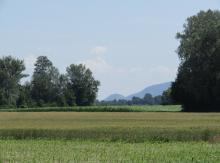Climate Protection through Soil Protection plants
Research study prepared by Bio Forschung Austria as part of the ATCZ142 Climate Green Projekt
Checklist climate fit
Soil Protection Systems
1. Selection of tree species
To ensure that hedges planted out today are well adapted to the climate in 20-30 years when they are fully grown, the expected climate change should already be taken into account when selecting the woody species.
Areas with a climate similar to that expected in the planting area in 20-30 years can be found southeast of the planting area and/or at lower altitudes than the planting area. Plants from these areas will probability be well adapted to the climatic conditions then prevailing in the planting area in 20-30 years.
Therefore, site types and young plants from these areas of origin are used, and species that also thrive there should be selected.
Species that are already at the edge of their heat and drought tolerance in the planting area should no longer be planted.
2. Avoidance of further stress factors by choosing the right location
In order to spare newly planted hedges additional stress, the location requirements of the woody species in terms of moisture (wet/dry), soil type (sandy/clay), pH value (acidic/basic) and humus content (rich in humus/poor in humus) should be considered even more than before .
In addition, the plants should be given sufficient space to stand and negative environmental influences such as de-icing salt, herbicides, game bites and other things should be kept away.
Mixed stands are preferable to monocultures because diseases and pests cannot multiply so easily here.
If individual species fail in mixed stands, the gaps can easily be closed by neighboring plants belonging to other species. Planting in autumn allows the plants to take root over the winter in the soil, what is still warm in summer but already moistened by autumn rainfall. Plants rooted in this way can more easily survive a drought in spring and early summer. While the soil already dries out from above in spring, the roots of the woody groves planted in autumn are already in deeper, more humid soil layers.
In the case of rootless deciduous shrubs, it is also advisable to prune the shrubs vigorously in order to reduce evaporation losses via the above-ground biomass.
Evergreens can assimilate on mild winter days and gain new reserves for winter root growth.
5. Optimisation of the maintenance of hedges and soil protection plants
For tall hedges and tree hedges, and especially if the windbreak function of a hedge is to be permanently maintained, a plenter-like care of the hedge is recommended.
In the case of plentering as permanent management of high and tree hedges, the removal of individual trees (overhangs) is accompanied by a hack of the lower shrub layer. The shrubs should be put on the stick in sections, always only in a section of a hedge, and staggered in time at intervals of a few years.
Through this type of care, the hedge is periodically thrown back into a "light phase" and rejuvenated. An overall stable, cyclically oscillating ecosystem "shrub hedge" between shade and light phases is formed and the hedge can fully fulfill its functions in the long term.
Download the study "Climate protection through soil protection systems" (German)
04.11.2025
EUSDR PA10: 12th Danube Participation Day in Sarajevo
more ...30.10.2025
Online-Präsentation BBK-Projekt CNSoil - Zwischenergebnisse
more ...07.10.2025
CatchHedge - Potenziale von Hecken im Zeichen des Klimawandels
more ...16.+17.09.2025
32nd Conference of the Danube Region
more ...12.09.2025
Grundlagen der professionellen Bio-Mandel-Produktion
more ...10.09.2025
Agroforst u. Marktgärtnerei, Symbiose
more ...05.09.2025
Regionales Wiesensaatgut gewinnen mit dem Wiesensamenernter
more ...25.06.2025
Feldtag - StripTill im Bio-Mais im Trockengebiet
more ...25.06.2025
Seminar: Wildbienen- und Nützlingsförderung im Biolandbau
more ...24.06.2025
BOKU Green Plate Forum 3.0
more ...24.06.2025
Die Maulbeere - Kultur, Produktion u.Verwendung
more ...17.06.2025
Frühjahrstagung Österr. Gesellschaft für Agrar- und Umweltrecht (ÖGAUR)
more ...13.06.2025
Seminar: Artenvielfalt in Ackerbauregionen fördern
more ...03.06.2025
Seminar: Keine Angst vor der Ackerdistel
more ...03.06.2025
Agroforstsysteme: Anbau-Modelle der Zukunft
more ...20.05.2025
IDM-Generalversammlung 2025
more ...15.05.2025
Seminar: Unkräuter/Beikräuter erkennen und als Zeigerpflanzen nutzen
more ...13.+14.05.2025
Bodenforum Österreich - Frühjahrstreffen
more ...04.05.2025
Tageskurs: Perma-Veggies - Mehrjähriges Gemüse und essbare Stauden
more ...03.05.2025
Waldgärten-Exkursion
more ...



